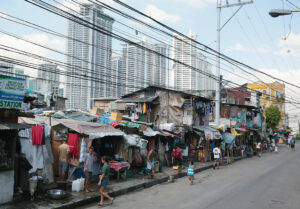Philippines records 22.4% poverty rate in first half
By Andrea C. Abestano Researcher The Philippines’ poverty rate for the first half of 2023 decreased to 22.4% from 23.7% in the same period of 2021, the local statistics agency said on Friday. The poor population declined by 895,260 to 25.242 million from 26.137 million in the January to June period of 2021, preliminary data […]

By Andrea C. Abestano Researcher
The Philippines’ poverty rate for the first half of 2023 decreased to 22.4% from 23.7% in the same period of 2021, the local statistics agency said on Friday.
The poor population declined by 895,260 to 25.242 million from 26.137 million in the January to June period of 2021, preliminary data from the Philippine Statistics Agency (PSA) showed. The poverty rate is a statistical measure that assesses the proportion of the population with income falling below the per capita poverty threshold.
The subsistence incidence, or share of the total population with per capita income lower than the per capita food threshold, fell to 8.7% from 9.9% two years ago.
This brings the estimated number of Filipinos whose income was not enough to buy basic food needs to 9.795 million, which is lower than the figures of 10.945 million in 2021 and 9.031 million in 2018, respectively.
National Economic and Development Authority Secretary Arsenio M. Balisacan said that the full reopening of the economy and the lifting of the pandemic restrictions since 2022 have helped the country recover from the impact of the public health crisis, leading to improved labor market conditions.
However, inflation partially offset the positive income growth on poverty, he noted.
“Had the inflation rate for the bottom 30 percent been at 4% in 2022, assuming the same increase in income, poverty incidence among the population would have been about 16% instead of the observed 22.4%,” said Mr. Balisacan.
Although the poverty threshold in the first semester of 2021 to 2023 rose by 14.2%, income increased substantially higher, National Statistician Claire Dennis S. Mapa said.
Poverty incidence across the country fell in 14 out of 17 regions in the first semester of 2023.
The only three regions that posted an increase were Western Visayas, with a poverty incidence of 26% (up from 25.3%); Zamboanga, with a poverty incidence of 38.2% (up from 37.4%); and Davao, with a poverty incidence of 27.2% (up from 19.4%).
“The decline in Philippine poverty in the first half of 2023 likely stemmed from economic recovery, government programs, and a comparison with a high 2021 baseline,” said Security Bank Corp. Chief Economist Robert Dan J. Roces in a Viber message.
Similarly, China Banking Corp. Chief Economist Domini S. Velasquez said in a separate Viber message that the improvements in economic activity “have led to better employment figures, thereby positively impacting Filipino families.”
The subsistence incidence among families recovered to 5.9% from the 7.1% in 2021.
Meanwhile, the poverty line or poverty incidence threshold, which measures the minimum amount needed by a family to supplement basic food and non-food needs, reached P13,797 per month for a family of five. This is higher than the P12,082 in 2021.
On the food threshold, P9,550 per month for a family of five was needed on average to meet basic food needs. This is higher by 18.10% from the P8,393 in 2021, as food-driven inflation pushed prices of commodities higher.
Despite the decline across poverty metrics, the figure remained far from the government’s goal of bringing down poverty to a single digit by 2028.
Moreover, Mr. Roces said that “the rapid decline might not be sustainable without long-term economic improvements.”
Inflation and global uncertainties remain a threat to the progress in lowering poverty, he also said.
“To achieve the ambitious target set by the Marcos administration of reducing poverty incidence to 9.0% by 2028, it is evident that more concerted efforts are needed,” Ms. Velasquez said.
Poverty data by the PSA were derived from the Family Income and Expenditure Surveys conducted every two years.














